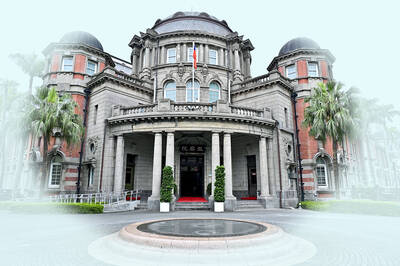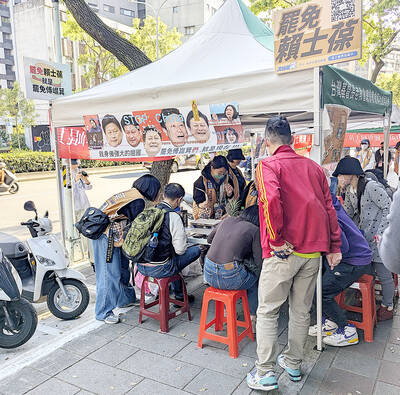You’ve heard of the National Palace Museum (國立故宮博物院), the Taipei Fine Arts Museum (臺北市立美術館), and probably even the Miniatures Museum of Taiwan (袖珍博物館), but chances are you’ve never heard of the Shung Ye Museum of Formosan Aborigines (順益台灣原住民博物館).
It’s not tucked away in some remote town or community. It’s in Shilin, diagonally across from the National Palace Museum. But on a recent Sunday, while the latter was teeming with hordes of visitors, hardly a soul strolled the display areas of the Shung Ye Museum.
Unfortunately, many tourists and even local residents neglect to take the time to learn about the history of Taiwan’s earliest inhabitants. Images of Aboriginal singers and dancers are widely used to promote tourism, and many tourists are taken by their tour guides to see Aboriginal performances, but few itineraries include a stop at a museum dedicated to the rich culture and fascinating lifestyle of the country’s Aboriginal tribes.
This is something the Shung Ye Museum’s operators and officials at the Executive Yuan’s Council of Indigenous Peoples (行政院原住民族委員會) hope to change, though they acknowledge they need to improve museums that showcase Aboriginal culture.
“In terms of professionalism, manpower and funding, museums focusing on indigenous people’s cultures are inadequate in all three areas,” said Chen Min-shong (簡明雄), chief of the culture section of the Council’s education and culture division.
“We’re hoping the museums can become more proactive, by reaching out to educational sectors and doing more self-promotion. Then people will come. We can’t simply wait for the tourists to show up,” Chen said.
Altogether, Taiwan has about 30 museums devoted to showcasing artifacts from Aboriginal cultures, not counting informal museums in community centers in areas where there are large Aboriginal populations. Many of the museums opened in the late 1990s, and all are non-profit.
Chen said that initially people in the communities where these institutions are located were slow to recognize the importance of their museum. But now the museums are slowly “becoming part of the community” and in recent years overall attendance has been increasing.
“Some museums now offer space for local artists to perform and local residents contribute items to the displays,” said Chen. “The residents also like to go there to see old photos.”
The Shung Ye Museum is the biggest museum of its kind in Taipei and the second-largest in the country. Other notable museums devoted to Aboriginal culture include the Wulai Atayal Museum (烏來泰雅民族博物館) in Taipei County, the Ketagalan Cultural Museum (凱達格蘭文化館) in Taipei’s Beitou District, and the Taiwan Indigenous Peoples Culture Park (台灣原住民族文化園區), which is operated by the Council of Indigenous Peoples Culture Park Area Management Bureau (文化園區管理局) in Pingtung and is the country’s largest.
The Shung Ye Museum is perhaps the most accessible and comprehensive of these and is at the forefront of efforts towards improving exhibits and attracting more visitors.
Lin Ching-fu (林清富), an ethnic Han Chinese businessman, opened the museum in 1994. At that time it was Taiwan’s first Aboriginal museum, said Lin Wei-chen (林威臣), the museum’s supervisor.
The initial collection of 800 to 900 items was donated by Lin Ching-fu, who had collected numerous Aboriginal artifacts over the years. The collection now comprises 2,000 items.
Each year, the large four-story structure attracts about 30,000 visitors. That is not considered a high number, given the museum’s size, convenient location and the fact that nearly three quarters of its visitors are students on field trips.
Lin Wei-chen said the museum is not well known among the general public. “People who know are those who really like Aboriginal culture or are students. Of course, we hope there could be more people who visit the museum. That’s the greatest hope of our founder,” he said.
Part of the reason for the low visitor numbers is that patrons might find the tickets too expensive compared to other museums, he said.
Ticket prices are already quite low, given the museum is entirely funded by Lin Ching-fu. This year, he contributed more than NT$40 billion, 90 percent of which came from his personal funds and 10 percent from his trading company, Shung Ye Co Ltd. None of that money is used for advertising, said Lin Wei-chen.
“We put all our budget into operating the museum,” he said, noting that the museum has only 10 employees, in addition to 50 volunteers.
To attract more visitors, the Shung Ye Museum has initiated a joint program with the National Palace Museum to offer cheaper admission if patrons buy tickets for both museums. Adults can visit both institutions for NT$250 and students for NT$130. (Admission to just the Shung Ye Museum costs NT$160 for adults and NT$150 for students.)
The museum has also steadily improved the quality of its displays. In the beginning, these consisted of items such as a model of a traditional house; later, people and animal figurines were added to enliven the displays, and a few years ago the museum commissioned videos to be filmed in Aboriginal villages to show museumgoers how people actually live in such houses. Additional videos show crafts such as cloth weaving, woodcarving and pottery making, as well as traditional dances.
There is little material concerning the problems Aborigines currently face, including encroachment on their land, high rates of unemployment and the danger of losing their languages and culture. But the museum does not shy away from referencing historical events, such as conflicts between Aborigines and Han Chinese settlers and the Wushe Incident (霧社事件) — the biggest and the last rebellion against Japanese colonial forces in Taiwan, which resulted in a massacre of hundreds of Seediq (賽德克) in 1930 by Japanese troops and rival Aboriginal warriors.
Lin Wei-chen said many Aborigines who visit are touched to find that man who founded and funds the museum is not an Aborigine, but he added that for some reason many do not spend much time gazing at the exhibits, perhaps because they believe they already know enough about their own history and culture.
Those who do stay end up learning things about their own tribe’s culture as well as that of other Aboriginal tribes, said Lin Wei-chen. “They might know their own tribe, but not other tribes.”

That US assistance was a model for Taiwan’s spectacular development success was early recognized by policymakers and analysts. In a report to the US Congress for the fiscal year 1962, former President John F. Kennedy noted Taiwan’s “rapid economic growth,” was “producing a substantial net gain in living.” Kennedy had a stake in Taiwan’s achievements and the US’ official development assistance (ODA) in general: In September 1961, his entreaty to make the 1960s a “decade of development,” and an accompanying proposal for dedicated legislation to this end, had been formalized by congressional passage of the Foreign Assistance Act. Two

Despite the intense sunshine, we were hardly breaking a sweat as we cruised along the flat, dedicated bike lane, well protected from the heat by a canopy of trees. The electric assist on the bikes likely made a difference, too. Far removed from the bustle and noise of the Taichung traffic, we admired the serene rural scenery, making our way over rivers, alongside rice paddies and through pear orchards. Our route for the day covered two bike paths that connect in Fengyuan District (豐原) and are best done together. The Hou-Feng Bike Path (后豐鐵馬道) runs southward from Houli District (后里) while the

The Taipei Times last week reported that the Control Yuan said it had been “left with no choice” but to ask the Constitutional Court to rule on the constitutionality of the central government budget, which left it without a budget. Lost in the outrage over the cuts to defense and to the Constitutional Court were the cuts to the Control Yuan, whose operating budget was slashed by 96 percent. It is unable even to pay its utility bills, and in the press conference it convened on the issue, said that its department directors were paying out of pocket for gasoline

On March 13 President William Lai (賴清德) gave a national security speech noting the 20th year since the passing of China’s Anti-Secession Law (反分裂國家法) in March 2005 that laid the legal groundwork for an invasion of Taiwan. That law, and other subsequent ones, are merely political theater created by the Chinese Communist Party (CCP) to have something to point to so they can claim “we have to do it, it is the law.” The president’s speech was somber and said: “By its actions, China already satisfies the definition of a ‘foreign hostile force’ as provided in the Anti-Infiltration Act, which unlike